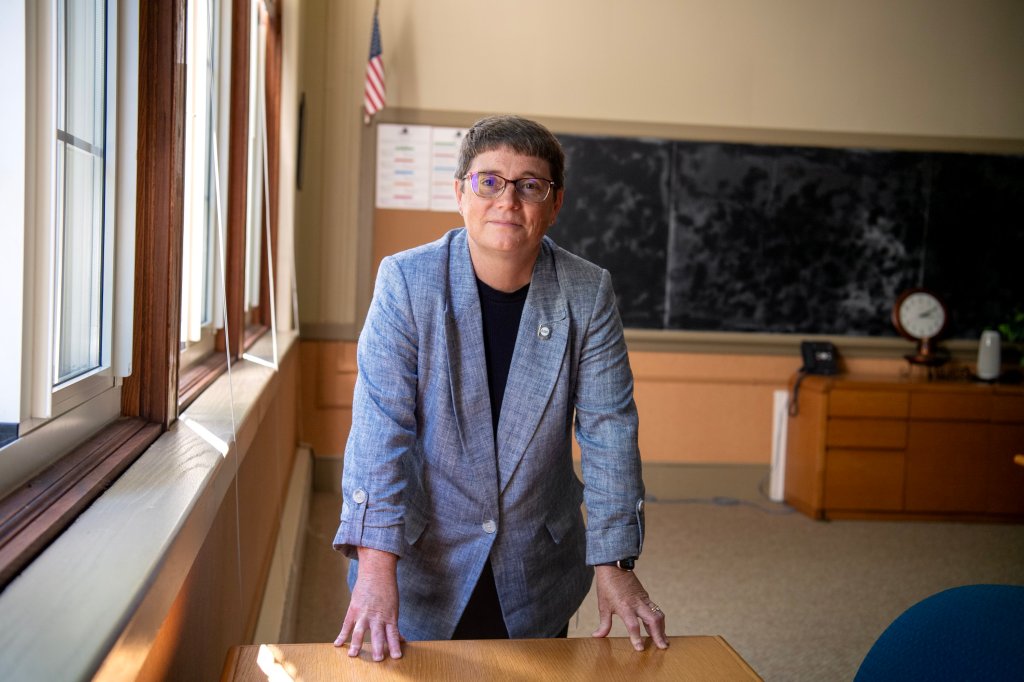Bethany Abramson remembers the fear she felt picking up her children from Gorham High School one day in January, but she can’t remember what prompted the school to dismiss students early — was it a bomb threat or a shooting threat?
“Which is sad,” Abramson said. “Because there shouldn’t be that many that you don’t remember which one, you know?”
Abramson is familiar with the district’s text alerts notifying parents about threats or lockdowns and secure-in-place orders. The text, she later recalled, noted that the school had received an unspecified threat they could not immediately deem a hoax.
What she wasn’t expecting, when huddling in the parking lot next to other parents waiting in their cars, was how calm the children were.
“I had this realization that, for them, it’s so common. They’re so desensitized to these types of things at this point,” she said in an interview Thursday.
Experts say lockdowns and other protocols in response to active threats can be traumatizing to students. In Maine, many school and law enforcement officials say their first priority is student safety and that they prefer to act with “an abundance of caution.”
So far this school year, at least six police operations and incidents across the state have prompted nearby school buildings to secure in place or cancel classes for the day.
Police executing search warrants in Gorham led several schools in the district to lock their doors twice since September. Gorham police also issued a “Code Red” alert to residents within a half-mile before carrying out a high-risk search warrant earlier this month.
Southern Maine Community College locked down at the end of last month while police were looking for a man threatening to hurt himself with a gun near Spring Point Ledge Lighthouse, not far from the South Portland campus.
And classes at Bowdoinham Community School were canceled last month while police worked to apprehend three teenage suspects who were accused of threatening someone with a weapon.
While not all public safety incidents warrant reports to the media, school leaders say they follow clear risk assessment plans before deciding to go into lockdown or securing in place.

HOW DO SCHOOLS DECIDE TO LOCK DOWN?
When there’s an active threat, the decision to go into lockdown isn’t black and white, Heather Perry, the superintendent of Gorham School District, said in an interview last month. There’s not a universal approach used statewide.
Perry said at her district, school leaders work with the Gorham Police Department to determine how serious a threat may be. They can respond with different levels of protection.
Under what’s known as a secure order, officials lock all exterior doors, but students continue normal classroom activities, whereas lockdowns include locking classroom doors and are used if the threat is inside the building.
Usually, if a nearby police operation involves an unpredictable suspect or weapons, Perry said she prefers to opt for a secure order to prioritize the physical safety of Gorham students, while also providing live updates to families.
“We tend to be very transparent in our communications as a way to mitigate some of those concerns,” Perry said. “People tend to react much better to information that they’re aware of and know about, rather than be surprised.”
Eric Waddell, director of the Maine School Management Association, said each district makes lockdown-related decisions based on its comprehensive school safety plan, a document required by state law that must be approved annually by the school board. There are model policies available from the state, but Waddell said the plans are usually modified to the specific circumstances of a district.
After the burglary suspects were apprehended in Bowdoinham, Superintendent Heidi O’Leary said in an interview last month that she had to consider whether school employees could reasonably return to work after a stressful situation.
O’Leary said students were already on their way to school when the incident was first reported. Children on buses were rerouted to safe locations and those already at school were placed into lockdown, which she said was taxing on staff, so they canceled classes for the day.
Jay Manhardt, the associate dean of Southern Maine Community College, said in an interview Thursday that last month’s lockdown was the first on campus since he started in 2008.
Security staff at many levels, not just a supervisor, have the authority to issue a lockdown and send a campus-wide alert to students, he said.
“We would rather lock the campus down … out of an abundance of caution,” Manhardt said. “On a campus like this, as many students as we have walking around, that’s completely warranted.”

WHAT THREATS SHOULD BE CONSIDERED?
Brian Higgins, a former law enforcement officer and lecturer on emergency management at the John Jay College of Criminal Justice in New York, said school districts must weigh how to keep children safe without disrupting their learning, and police have a responsibility to keep a tight perimeter.
A school’s threshold for locking down can vary depending on the type of police operation, how close it is to the school and even the landscape of the area, he said.
For example, Higgins said police and school leaders should consider if an assailant could easily run into a school building, if a fired bullet could strike a student or if a student could be mistaken for the suspect.
But those considerations vary between districts and police agencies. Last spring, in Portland, a student was mistakenly apprehended by South Portland police who were executing a high-risk search warrant a few blocks from Deering High School during lunch period.
The school didn’t lock down, and school officials weren’t notified about the operation beforehand, a spokesperson for Portland schools said in a statement last month.
“(Police) have acknowledged that this was a mistake and have committed to reviewing their practices to ensure it doesn’t happen in the future,” according to the statement. South Portland police would not comment on the incident.
HOW CAN SCHOOLS AVOID TRAUMA?
Emilie Ney is a school psychologist and oversees school safety and crisis response work at the National Association of School Psychologists. She said the psychological impact lockdowns have on students depends on how the school handles them.
“The amount of preparedness that the schools have and the way that they carry out the procedure is going to go a long way in determining what impact it’s going to have on the students,” Ney said.
She said studies show that careful preparation and a thoughtful approach can mitigate potentially stressful or traumatic impacts of the drills themselves. For example, she said drills should always be announced as such in advance, and staff should remain calm and confident.
The organization recommends avoiding “highly sensorial drills” that involve simulation activities or gunshot sounds to mimic a real experience, because nonsensorial drills can be just as effective without being traumatizing.
Waddell, of the Maine School Managment Association, said that in his previous role as the superintendent in Kittery, district leaders worked with local emergency management teams, the fire chief and the police chief in order to design their plan, and even conducted a mock crisis scenario to address details.
Waddell said that schools should consider the emotional needs of students and staff.
“We certainly do worry about the potential trauma that that has, that even rehearsing these scenarios has on students, and staff, too, for that matter,” Waddell said. “Remembering that the safety of our students and staff is the absolute most important thing, we also realize that we need to be attuned to the students and staff.”


We invite you to add your comments. We encourage a thoughtful exchange of ideas and information on this website. By joining the conversation, you are agreeing to our commenting policy and terms of use. More information is found on our FAQs. You can modify your screen name here.
Comments are managed by our staff during regular business hours Monday through Friday as well as limited hours on Saturday and Sunday. Comments held for moderation outside of those hours may take longer to approve.
Join the Conversation
Please sign into your CentralMaine.com account to participate in conversations below. If you do not have an account, you can register or subscribe. Questions? Please see our FAQs.